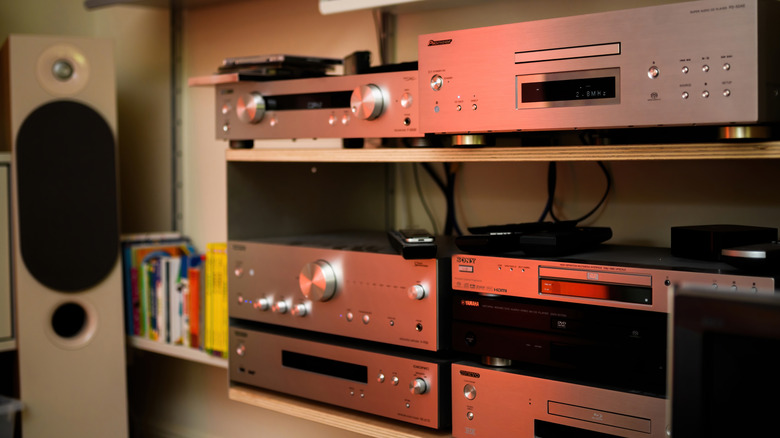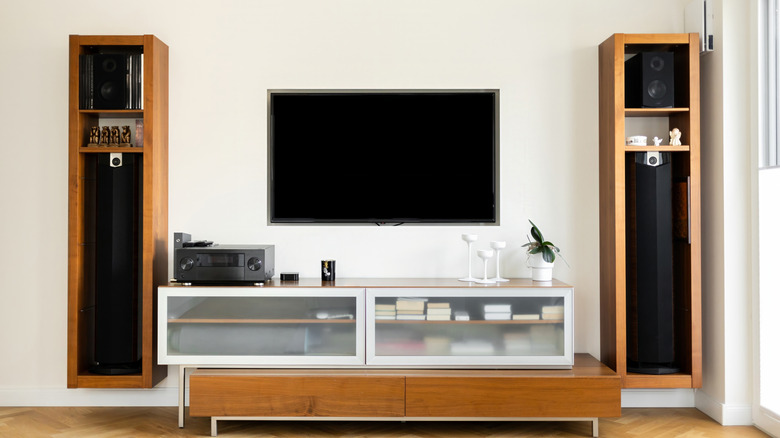4 Key Things To Consider When Building Your Home Surround Sound System
Certain things signify a level of well-earned luxury on the home front. While things like a swimming pool, high-end appliances, and the latest in smart home gadgetry tend to dominate such conversations, for some homeowners, the luxury line is officially crossed with the setup of a snazzy surround sound system in their living room.
That's particularly true for folks who prefer to spend their nights, weekends and holidays perched comfortably on the couch or in a recliner as they watch the latest hit series or major motion picture to hit the streaming realm. If such entertainment is your primary pastime, you no doubt prefer your home viewing experience to resemble, as closely as possible, the one you have when you visit the local movie theater. And to do that, you'll need to properly outfit your space with the requisite surround sound system.
There is, of course, more to setting up a home surround sound system than just getting your hands on the right gear. In fact, to do surround sound the right way, most audio experts might be quick to tell you that there are dozens of factors to consider when plotting out your setup, and that the devil is indeed in the details when it comes to optimizing sound. Here are a few things they might encourage you to consider when building out your home surround sound system.
Your audio goals will also impact the components you need
Selecting what components and audio accoutrements to utilize in your system will easily be among the most important decisions you make. And yes, those decisions will likely also rank among the most difficult, if only because there are so many brands of note and products at play in the audio arena these days.
But before you begin searching through the various speakers and components you'll need to complete your system, you need to ask yourself what your ultimate goal is for your sonic experience. For instance, if your primary goal is to recreate the theatrical experience when you're binging away on the couch, you'll need to ensure that you've procured components and an array of surround speakers that are capable of delivering the multi-channel sound affixed to most movies and television shows being produced today.
Yes, the surround sound you desire when watching movies is very different from the 2-channel stereo sound you typically hear when you're rocking out to the pop tunes, punk rock, or Pavarotti that may currently be occupying your Spotify playlist. If music is a master in your home, a surround sound system geared towards that may be best. Even as amplifiers and receivers should offer optimized audio options for both movie sound and music, if the sound of cinema is important to you, you should prioritize components built to bolster those features.
Different surround sound formats deliver different audio experiences
When researching components, you'll want to pay attention to their audio channels and which surround sound format they are best-equipped to support. These days, the most prominent formats come from Dolby Labs and DTS. Yes, both surround sound formats are regularly featured at modern multiplexes. Each format has also long been available for home theater use. However, each may offer slightly different returns in your surround sound experience, with the belief being that DTS' less compressed, higher bitrate setup may offer better clarity, even as Dolby remains a go-to format in the industry.
Audio channels are, understandably, a big part of the surround sound format conversation, as the general rule of thumb is that the more channels you have, the more immersive your surround sound should be. Both Dolby and DTS systems offer similar channel ranges, from 5.1 up to 11.1. For now, 5.1 is still a relatively common layout in the sound industry, with many streamers offering content in that audio range.
For what it's worth, Dolby is the format favored by many of the more prominent streaming services, including Netflix, Disney+, Amazon Prime Video, Paramount+, Apple TV+, and Max. Those factions also support Dolby's Atmos surround sound if you're looking for components and speaker packages with that capability. Likewise, Disney+ even supports DTS:X for some IMAX and MCU content if you're looking at that high-end package. In terms of physical media, most DVDs are optimized for Dolby Digital, though they may also support DTS audio packages.
Room acoustics and speaker placement can make or break your surround sound setup
Once you've made those decisions, it's time to consider room acoustics and speaker setup. For those of you lucky enough to be building a home theater from the ground up, this will be less of an issue, as you'll be able to design a room specifically to optimize your sonic desires. It's safe to assume, however, that most folks are working with a pre-existing space in their home, which will require a little more layout planning.
It may prove fortuitous that said space likely already resembles a movie theater, as the rectangular layout is considered ideal for an immersive surround sound setup, and many living rooms indeed fit that bill. Even still, there are other factors to consider, like the overall size of the room, or the location of your furniture and wall hangings, as each will affect the manner in which sound is distributed throughout the space. In general, the idea is to limit objects that might block or reflect sound, as this can unbalance acoustics on the high and low ends of the sonic spectrum.
Once your furniture is placed, speaker setup can begin. The general logic is that larger speakers and a center speaker should be situated directly in front of your seating, with smaller "surround" speakers placed slightly behind on either side. Likewise, if you've gone the Atmos route, additional speakers may need to be fixed to your ceiling. In-room sound design can be a legit make-or-break science, meaning it may pay to consult an acoustics expert when you're setting up your surround sound system.
Budget is a big part of putting a system together
With those factors covered, one could easily argue that the first thing you need to think about before you head out to the closest electronics store is exactly how much money you're willing to spend on the setup. And for the sake of being crystal clear on this point, buying the requisite components you'll need to properly set up your system will likely be a pricey endeavor, as receivers, amplifiers, woofers, and speakers from even the lower-end electronics brands may not come cheap. On the high end of the market, such a setup could easily cost many thousands of dollars.
Given those facts, it is, understandably, vital that you come up with a dollar amount you're comfortable with spending on your surround sound experience. It's even more important that you actually stick to that budget when you start shopping, 'cause it can be all too easy to get swept up and inadvertently drop some serious green when you're plotting out your home theater setup.
The good news is that electronics big box retailers like Best Buy offer more budget-friendly options in the surround sound arena, often packaging receivers, speakers, and woofers together at a lower cost than you might see purchasing each individually. These days, most electronics manufacturers are also making soundbars that claim to deliver room-filling surround sound (including even Dolby Atmos) to your home theater setup in one easy-to-manage package — though prices can be pretty steep for a high-end soundbar as well.




